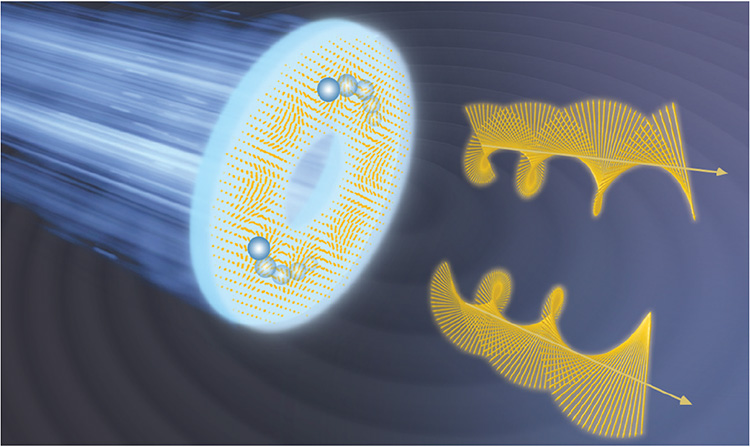 Vectorial polarization fields for vectorial Doppler metrology.
Vectorial polarization fields for vectorial Doppler metrology.
The Doppler effect, throughout its history and in its wide applications, has always depended on scalar waves to detect the characteristic frequency shift. For low-frequency scalar waves, such as water waves and acoustic waves, this is easily realized through direct detection. For ultra-high-frequency electromagnetic waves, in contrast, extracting the Doppler shift usually requires interference with a coherent reference light—not only for the conventional longitudinal Doppler effect, but also for the more recently described rotational (transverse) Doppler effect.1,2
Such interference techniques, however, allow only the magnitude of the velocity to be directly detected, and inherently lose information on the direction of motion. Conventional direction detection requires auxiliary techniques, resulting in complex, non-compact and even high-cost measurement systems. In recent work, we have demonstrated new methods for Doppler direction detection in vectoral polarization fields (VPFs) that avoid these complications and open new application prospects.
Apart from the well-known scalar properties (amplitude and phase), optical fields also possess the dimension of polarization. Unlike the uniform polarization distribution within scalar optical fields, VPFs feature spatially varying polarization vectors, which have gained increasing interest and seen rapid development in diverse applications. The most typical VPFs are azimuthal and radial polarization fields, as well as higher-order VPFs described by the equator on the higher-order Poincaré sphere.3
In a study published in 2017, we revealed the internal relationship between rotational and linear Doppler shifts for vortex beams with spatially helical phase distribution.4 More recently, by analyzing the Doppler polarization signals (DPSs) of VPFs when interacting with a moving particle, we found that the 2D DPSs inherently carry information not only about the magnitude of movement velocity but also about its direction.5 We proposed a metrological method to retrieve or track the motion vectors by analyzing the DPSs through two polarizers with a fixed polarizing-angle difference.
Our demonstration indicated that the relative phase difference (RPD) between two linear polarization components of the DPSs, regarded as the Doppler phase shift, can significantly supplement conventional measurement of the Doppler effect using scalar optical fields, which provide only the Doppler frequency shift. We also were able to instantaneously identify the particle position, given knowledge of its starting position and continuous tracking.
Finally, we discussed the general case of anisotropic particles with the Jones matrix method. We found that it is possible to distinguish the rotation and spin of an anisotropic particle and to measure the rotational velocity and spin speed (magnitude and direction) by analyzing Stokes parameters or using a simplified setup with two polarizers.
Because it fully exploits the dimension of spatial polarization, our vectorial Doppler metrology approach facilitates detection of the motion vector without interference with an additional reference light, and with minimal environmental disturbance. We believe these findings will benefit emerging applications in advanced optical metrology, both for the natural environment and for industry.
Researchers
Liang Fang* and Zhenyu Wan,* Huazhong University of Science and Technology, Wuhan, Hubei, China
Andrew Forbes, University of the Witwatersrand, Johannesburg, South Africa
Jian Wang, Huazhong University of Science and Technology and Optics Valley Laboratory, Wuhan, Hubei, China
*These authors contributed equally to this work.
References
1. M.P.J. Lavery et al. Science 341, 537 (2013).
2. C. Rosales-Guzmán et al. Sci. Rep. 3, 2815 (2013).
3. D. Naidoo et al. Nat. Photon. 10, 327 (2016).
4. L. Fang et al. Laser Photon. Rev. 11, 1700183 (2017).
5. L. Fang et al. Nat. Commun. 12, 4186 (2021).
